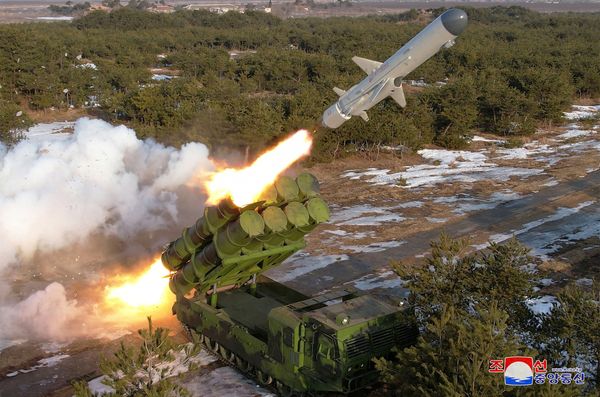The most powerful rocket ever built exploded in the skies over Texas in April. Just five days later, Japan's first-ever lunar landing attempt failed as its small spacecraft apparently crashed into the moon. Yet days before, the European Space Agency (ESA) succeeded in launching an unmanned exploration mission to Jupiter's moons.
In another era, it may have looked like the final lap of a global space race. But in the third decade of the 21st century, it was space business as usual. Current generations of aerospace engineers, scientists, entrepreneurs and military leaders are hustling to stake claims to portions of the space surrounding Earth's atmosphere.
"We are at a time of explosive innovation in the space industry," said Satellite Industry Association President Tom Stroup, in an interview with IBD. "There's a tremendous amount of activity going on."
"Explosive innovation" was a good way to describe the April 20 launch of the giant Starship rocket. The vehicle, owned by Elon Musk's SpaceX venture, blasted off from a launchpad near Boca Chica Beach at the southernmost tip of Texas and disintegrated shortly after liftoff.
Musk framed the crash as a positive — a big step forward on the learning curve. But that kind of volatile progress has kept many investors at arm's length from the industry, and has left shares of publicly traded space firms in the dustbin.
For all its growth and breakthroughs, the space industry faces big challenges, from space junk and torrid competition to security risks of all kinds. Regulation also remains a major question, as the rising pace of rocket launches by corporate and government players drives the space economy and Earth's orbiting objects toward overload.
How busy and diverse are the efforts to populate the heavens? Among other milestones, China completed its new Tiangong space station in November. Regular launches service the ongoing U.S.-EU joint support of Spacelab, which is scheduled to continue through 2031. The ESA's unmanned Juice exploration mission is on its way to Jupiter's moons. And global researchers are delving into new aspects of distant space with the powerful James Webb Space Telescope, launched in 2021.
Satellites Launch New Space Race
Data on the space industry varies widely. The most recent estimates from engineering and analysis firm BryceTech put the total value of the global space economy at $368 billion in 2021. That tally includes $142 billion in ground equipment and networking gear.
But the most frenetic venue of the current space race is in Earth-orbit satellites. BryceTech puts the annual size of the global satellite industry at $279 billion in 2021, and growing at an accelerating pace.
Because launches sometimes fail and satellites expire or periodically fall out of the sky, exact numbers are hard to pin down. In March, ScienceNews reported about 7,300 active satellites are in orbit, according to astronomer Jonathan McDowell using data from SpaceX and the U.S. Space Force.
How Many Satellites In Orbit?
In April, Geospatial World reported that the United Nations Office for Outer Space Affairs (UNOOSA) counted 8,261 satellites in orbit as of January 2022. Of those, 4,852 were said to be active at the end of December 2021. Those numbers were reportedly confirmed by the Union of Concerned Scientists (UCS), which keeps track of operational satellites.
That's up from fewer than 1,000 in 2010, according to the UCS. Over the past two years, the Federal Communications Commission has received applications for over 64,000 new satellites, according to the Center for International And Strategic Studies (CSIS).
Among those plans, the Starlink communications unit owned by Space Exploration Technologies Corp., or SpaceX, is approved for 7,500 new satellites. Amazon's Project Kuiper, set to begin mass-producing satellites this year, aims to launch a total 3,236 units. A 36-satellite launch by London-based OneWeb in March put the company's orbiting fleet at more than 600, with a planned total of 648. Canada's Telesat Lightspeed operates a 188-satellite constellation.
Beyond the commercial realm, there is also the matter of China's military. Energized by the communications capabilities developed by the Ukraine military, using Musk's Starlink system, to defend the country against Russia, China is determined to dive deeper into the satellite space race. It now plans a spray of 13,000 state-backed satellites, according to recent reports from the CSIS and the Washington Post.
Elon Musk And Other Top Satellite Players
Like most electronics, satellites in the days of old could be massive and cumbersome. But the current blur of launches owes largely to the creation of miniature satellites, called cubesats. Satellites were once the size of buses. Today's satellites pack more power and capability into a package the size of a microwave oven or a shoe box.
That means that even though today's rockets are often smaller than those of the prior era, they can release many more satellites in a single launch.
Among existing U.S. and European satellites, the vast majority are commercial. Musk's Starlink, Amazon's Project Kuiper and OneWeb, owned by the U.K. government and Bharti Global, an Indian multinational conglomerate, are currently the three largest players in the commercial satellite market. All of their constellations revolve around providing broadband internet access worldwide.
Data from Statista showed the U.S. accounted for 3,433 satellites as of April 2022. China had 541, and Russia owned 172. Combined, the three represent about 53% of the total, according to Statista's data. Again, exact numbers are difficult to pin down, but this gives a sense of the relevant stake holders.
Demonstrating the inconsistency of reported numbers, Musk, for example, has reportedly already placed about 4,000 Starlink cubesats in orbit, according to another source, giving it the clear lead in the commercial space race. And in December, the FCC granted SpaceX approval to launch 7,500 more satellites.
"We're looking at an enormous jump in satellites over the next 10 years," said Lesley Conn, director of research and digital programs at Space Foundation, a nonprofit organization that advocates for the global space industry.
LEOs Vs. GEOs
Nearly all of the newer satellites are destined for what is called low-Earth orbit, or LEO. That puts them between 160 miles and 2,000 miles above the Earth's surface. Just over half the current orbiting population are LEO satellites.
Most of the rest are situated much deeper in space, between 20,000 and 26,000 miles. These are called geosynchronous Earth orbit units, or GEOs.
GEOs orbit at the same speed as the Earth's rotation. This 24-hour cycle keeps them in a more or less steady position above the planet. They maintain a constant view of about a third of the Earth's surface.
Meanwhile, LEOs are the sprinters of the new space race. They circle the planet every 90 minutes. That means LEO satellites wink in and out of range fairly rapidly. They can provide service to any given location on the planet for only a short period of time.
Systems like Starlink and Project Kuiper must therefore put up swarms of satellites, so users can easily shift from satellite to satellite as LEOs move out of range.
But LEOs have advantages. Low-Earth orbit satellites can receive and transmit signals more quickly. This reduces the lag, called latency, of signal travel time. GEOs, on the other hand, experience higher latency rates. This slows communications and can cause problems with many types of software.
What Are C4isr Satellite Capabilities?
Nimble LEO transmission has provided distinct advantages in situations such as Ukraine, where Musk has provided Starlink internet access at no charge to Ukrainians and the Ukraine military. The result has made the war something of a laboratory for the capabilities sophisticated LEO networks can provide. The military labels these capabilities C4isr (command, control, communications, computers, intelligence, surveillance and reconnaissance).
C4isr enables, among many other things, soldiers in the field to snap and send digital photos to air and military support units, including artillery and air support — what the Economist magazine described as "a sort of Uber for howitzers." It also makes possible more intricate control over other types of targeting and drone warfare.
"This kind of connectivity is something no previous army has enjoyed," according to the Economist.
Space Race Becomes An Obstacle Course
Starlink's long-term goal calls for 30,000 satellites. The FAA's Commercial Space Transportation office and the Federal Communications Commission have the final say on space launches.
SpaceX's enormous Starship rocket is designed to haul up to 100 persons on "long-duration, interplanetary flights." It could also reportedly haul up to 100 satellites per launch. The smaller Falcon 9 can handle 60 cubesats per launch.
The Falcon 9, a reusable rocket, hauled a payload of 46 Starlink satellites into orbit April 27. The Starship aims to eventually be reusable.
But the vast majority of objects launched into space have not been reusable. That abandoned junk, and the many collisions it has caused, has left the Combined Space Operations Center (CSpOC) at Vandenberg Space Force Base in California tracking more than 32,000 potentially dangerous objects circling the Earth.
The European Space Agency reports that more than 560 "in-orbit fragmentation events" have occurred since 1961.
Only seven of those events involved collisions. Most were explosions of spacecraft and upper stages of rockets. Looking ahead, collisions are expected to become the dominant source of new space debris.
In July, the White House released an orbital debris implementation plan, making clear that the Earth's orbits "are finite resources and can be threatened by the rapid, uncontrolled increase in orbital debris. "
The ESA plans to launch its first debris removal project in 2025. Commercial companies, such as Privateer Space, are also stepping in and creating markets for risk management and waste reduction and management in space.
Satellite Cybersecurity Risks
The FCC has tightened long-standing rules that allowed dormant satellites to remain in orbit as long as 25 years. In September, the agency cut that horizon to five years for low-Earth orbit. China provided one example of how to conduct space maintenance. In 2021, its Shijian-21 satellite docked with and towed one of its defunct satellites out of geosynchronous orbit.
Other risks include attacks on satellites that jeopardize communications, information security and defense systems. Information from the National Security Archive says that, in 2021, Gen. David Thompson, the U.S. Space Force's second-in-command, stated that, "Both China and Russia are regularly attacking U.S. satellites with non-kinetic means, including lasers, radio frequency jammers, and cyberattacks."
Most of the attacks remain classified, the NSA reports. However, a few have been disclosed. One was a Feb. 24, 2022, Russian cyberattack on Viasat communications satellite ground infrastructure that interrupted service to Ukraine and several European nations. China and Russia also have operational direct ascent (missile-launched) antisatellite weapons armed with conventional explosive warheads that can destroy satellites in low-Earth orbit.
A report on April 26 from the Washington Post cited recently leaked top-secret U.S. intelligence documents that said Russia's space programs were weakening but still a threat. China, meanwhile, has developed "significant capabilities," able "to hold key U.S. and Allied space assets at risk," and would "deploy them in any conflict with Taiwan."
Amazon Investment In Project Kuiper
Meanwhile, the private-sector space race dashes ahead. The No. 2 satellite player, Amazon, has pledged to invest more than $10 billion in Project Kuiper, said Julie Zoller, head of global regulatory affairs at Amazon, in a statement to the House Energy and Commerce Committee hearing in February.
The project's name salutes Dutch-born astronomer Gerard Kuiper, considered by many to be the father of modern planetary science. Project Kuiper initially planned to launch its first two satellites via United Launch Alliance's Vulcan Centaur rocket early in 2023. In March, it pushed that schedule into 2024.
Amazon says ULA, a joint venture between Lockheed Martin and Boeing, is scheduled to provide 47 launches for its satellite constellation. Amazon recently began construction on an advanced satellite manufacturing facility in Kirkland, Wash., enabling it to build up to four satellites a day, Zoller said.
On March 14 the company debuted three models of antennae expected to go into use in 2024. The larger ones are 28 centimeters and can generate speeds up to 400 megabits per second. The smallest ones are the size of a Kindle e-book reader, capable of speeds of up to 100 Mbps.
But don't confuse Project Kuiper with Blue Origin, a rocket ship company established in September 2000 by Amazon founder and former Chief Executive Jeff Bezos. Blue Origin's rocket ship is, for now, primarily a space-tourism vehicle that seats six. Bezos has invested a reported $7.5 billion of his own money into the company.
Blue Origin provides rocket engines to the United Launch Alliance, delivering the first engines for the Vulcan Centaur rocket in October.
Elon Musk's Space Race Role
Musk in the late 1990s put into motion the research and development for what became SpaceX. His selling point was the ability to launch satellites into space at a steep discount compared to traditional providers such as Boeing and Lockheed Martin. That spurred other aspiring entrepreneurs to enter the commercial space field.
Following Musk and Bezos, British entrepreneur Richard Branson launched his Virgin Galactic spaceflight operation in 2004. Its VSS Unity marked the company's first spaceflight in 2018. In March, after an extensive overhaul, the company said both of its vehicles are now ready for test flights.
In February last year, the company began reserving space flights to the public, at $450,000. The company initially said tickets would be available last year to 1,000 customers. The timeline for those flights remains unclear.
But the biggest effort in the industry, "where most investor capital is being spent, is in the effort to significantly reduce launch costs and increase launch capacity," said Robert Jacobson, founder and chief executive of Space Advisors, a financial and strategic consulting firm that mentors startups. He is also author of "Space is Open for Business."
Costs have dropped from $5,400 per kilogram on a Saturn V rocket in 1967, to $1,500 per kilogram for a SpaceX Falcon Heavy in 2018, according to data from the CSIS Aerospace Security Project.
Space capabilities once reserved for nation-states, but now available to private operators, enable a wider range of uses and greater transparency. That is a result of the lowered cost of satellites and quickened pace of launches, Jacobson said.
SpaceX Venture Capital Funding
The headline-making milestone launches of Musk, Bezos and Branson helped lure more entrepreneurs into the market.
"Those were catalyzing moments," said BryceTech Chief Executive and founder Carissa Bryce Christensen. Those moments "helped bring in private-sector funding as new opportunities emerged," she said.
According to information reported by CNBC, SpaceX in January was looking to raise $750 million in venture capital. Andreessen Horowitz (also known as a16z) was a likely leader in the new funding round. Earlier investors in the company included Founders Fund, Sequoia and Gigafund.
Musk has said he will bring the company, which is reportedly already profitable, public when the time is right.
But buying space stocks right now is for thrill-seekers only. None of the younger space race companies is profitable, though some are growing revenue at double- and triple-digit rates.
Industry Consolidation Amid The Space Race
Space launch company Rocket Lab USA provides an example. For its fiscal 2022, Rocket Lab reported revenue of $211 million, up 239% from the prior year. But the company posted a net loss of $135 million.
Rocket Lab came public in August 2021 through a special purpose acquisition company (SPAC), which valued the company at $4.8 billion at the time. Its current market value is less than $2 billion. Its shares recently traded below 4 — 82% off their September 2021 high. The company designs, manufactures and launches orbital rockets to deploy payloads for government and commercial missions.
Redwire came public via a SPAC in September 2021. The company makes space infrastructure products. The stock tumbled from a high of 16.98 in October 2021 to trade near 3 recently.
Meanwhile, Virgin Galactic began trading on the New York Stock Exchange in 2019 by way of a SPAC. Shares are down 95% from their February 2021 high.
Among Branson's portfolio companies, Virgin Orbit was the satellite launch unit. Spun off from Virgin Galactic in 2017, the company in April declared bankruptcy. A federal bankruptcy court approved plans to sell the company, with bids set to run through May 15.
The sale stirs long-running discussions of consolidation in the satellite space industry. The Wall Street Journal quoted Inmarsat Global CEO Rajeev Suri in January as forecasting that industry overcapacity and deep-pocketed new players would create a recipe for consolidation.
"Not in the distant future, in the near term, '24 or '25, you will get overcapacity, so consolidation, in my mind, is inevitable," he said.
Other struggling, space-related stocks include Astra and Momentus Space, which both trade now below 1.
Today's Satellites, Tomorrow's Space Junk
With all the innovation by startup companies, some have taken to calling space the new Silicon Valley.
"Space, 62 miles up, has become home to lots of hyperbolic ideas and untested business models," Space Advisors' Jacobson said. "Like Silicon Valley, it's a frontier-oriented sector built by people focused on building a future they want. Space is just on the edge of the kind of revolution in accessibility that made Silicon Valley what it is today."
But the overarching question is how to manage all of this new growth. Land rushes come with consequences. And the companies launching new equipment into the Earth's atmosphere are often decades ahead of the regulators straining to understand the technologies and how to best manage them.
Dr. Moriba Jah is the chief scientist with Privateer Space, a company Jah launched with Apple co-founder Steve Wozniak and tech innovator Alex Fielding. Privateer aims to more accurately track, manage and reduce both risk and waste in the rising space economy.
"Elon has shown that we can reuse and recycle a rocket ship, so A+ for that," Jah said in an IBD interview. But none of the satellites going into space are reusable or recyclable, he says, and disposal of space objects in general has often meant simply abandonment.
YOU MAY ALSO LIKE:
Keep Up With The Latest Space Industry News And Top Space Companies
Lockheed Eyes Space-Based 5G Network As SpaceX Becomes Bigger Rival
SpaceX Starlink Impresses Air Force Weapons Buyer In Big Live-Fire Exercise
Want To Get Quick Profits And Avoid Big Losses? Try SwingTrader







